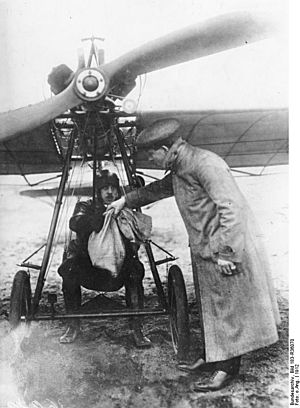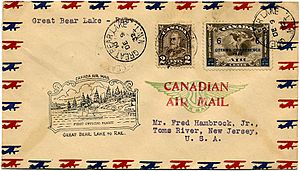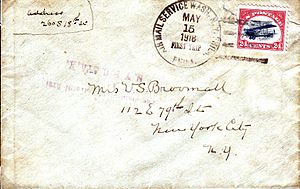Airmail facts for kids
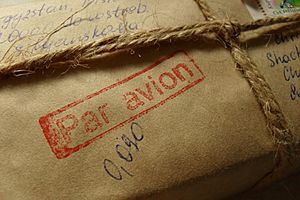
Airmail is a way to send mail using airplanes for at least part of the journey. Airmail usually arrives much faster than mail sent by land or sea. It also costs more. For some places, especially overseas, airmail might be the only way to send mail quickly, as waiting for a ship could take weeks.
The Universal Postal Union is a group that sets rules for mail around the world. In 1929, they made official rules for airmail. Because their main language is French, you often see "Par avion" on airmail items. This simply means "by airplane."
In the past, airmail was a special service, separate from regular mail. Today, mail services often decide how to send your letter based on how fast it needs to get there. This means even "regular" mail might travel by plane sometimes! This is called "air-speeded" mail. It's different from official airmail because of its price and how quickly it's handled.
Contents
History of Airmail
Early Flights with Mail

People sent messages by air long before airmail became a regular service. For example, homing pigeons were used to carry messages for a very long time.
The first time mail was carried by an air vehicle was on January 7, 1785. This happened during a hot air balloon flight from Dover in England to France. The balloon was flown by Jean-Pierre Blanchard and John Jeffries. They carried a letter from William Franklin to his son.
On January 9, 1793, Jean-Pierre Blanchard made the first balloon flight in North America. He flew from Philadelphia to Deptford, New Jersey. He carried a personal letter from George Washington. This letter was meant for the owner of the land where Blanchard landed. This made it the first airmail delivery in the United States.
Balloons also carried mail out of Paris and Metz during the Franco-Prussian War in 1870. They flew over the German forces that were surrounding these cities.
Airplanes and Mail
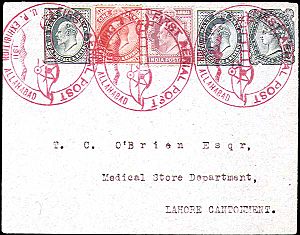
When airplanes were invented around 1903, people quickly saw their potential for carrying mail. The first unofficial airmail flight happened on February 17, 1911. Fred Wiseman carried three letters between Petaluma and Santa Rosa, California.
The world's first official airmail flight took place the very next day in British India. Sir Walter Windham organized an aviation show and got permission to offer an airmail service. This was to promote the show and raise money for charity.
Henri Pequet was the pilot for this historic flight. He flew 6,500 letters about 13 kilometers (8 miles) from Allahabad to Naini. The letters had a special mark saying "First Aerial Post." The flight took only thirteen minutes using a Humber-Sommer biplane.
The first official American airmail delivery was on September 23, 1911. Pilot Earle Ovington made this flight. In Australia, the first official airmail was carried by Maurice Guillaux in 1914. He flew 940 km (584 miles) from Melbourne to Sydney. This was the longest such flight in the world at the time.
Regular Airmail Services
The world's first regular airmail service started in the United Kingdom on September 9, 1911. It flew between Hendon (near London) and Windsor. This service was part of the celebrations for King George V's coronation.
This service ran for almost a month. It carried 35 bags of mail on 16 flights. Pilots like Gustav Hamel flew the planes. He covered the 21 miles between Hendon and Windsor in just 18 minutes. However, the service stopped due to bad weather. Similar services started briefly in other countries like Germany, France, and Japan, but they also faced difficulties.
After World War I, airplanes became much better. They could fly farther, faster, and carry more weight. This made regular airmail services finally possible. The first regular airmail service in the United States began on May 15, 1918. It flew between Washington, D.C., Philadelphia, and New York City.
In the 1920s and 1930s, large airships called Zeppelins were also used to carry mail in Germany. This was known as Zeppelin mail. Many countries even made special stamps just for Zeppelin mail.
International Airmail
After World War I, the British military started the first regular international airmail service. It flew between Folkestone in England and Cologne in Germany. This service helped British soldiers in Germany get their mail quickly.
On December 25, 1918, Latécoère Airlines (later known as Aéropostale) started the first civilian international airmail service. Mail was flown from Toulouse, France, to Barcelona, Spain. Soon after, in February 1919, the service was extended to Casablanca, Morocco. This made Latécoère Airlines the first airline to offer transcontinental airmail.
The first official airmail service by an airline began in Colombia, South America, on October 19, 1920. Scadta, the country's first airline, delivered mail by flying along rivers. Australia's first airmail contract was given to Western Australian Airlines in 1921. They carried mail between Geraldton and Derby.
Collecting Airmail Stamps
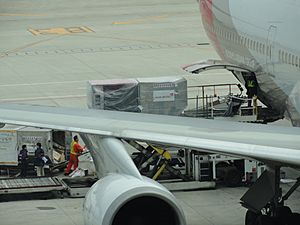
Stamp collecting was already popular when airmail started. Collectors were very interested in these new services. They tried to get letters sent on the very first flights between different places. Postal services often used special marks called cachets on these letters. Sometimes, the pilot would even sign them!
The first stamps made just for airmail were issued by Italy in 1917. These were used on test flights. Austria also made airmail stamps in 1918. The United States then issued the first official airmail stamp in May 1918.
Air-Speeded Mail
Sometimes, a postal service might send regular mail by air even if you didn't pay for airmail. This might happen if other ways of transport are not available. You usually can't tell this by looking at the envelope. This kind of mail is not considered "airmail." Official airmail usually has a guaranteed flight and arrives first. Air-speeded mail waits for any available flight and might arrive later than official airmail.
Airmail Names
A letter sent by airmail can be called an aerogramme, aerogram, air letter, or simply airmail letter. An aerogramme is a special type of airmail letter that is its own envelope. To keep the weight down, some airletters, like aerogrammes, might not allow you to put other things inside.
You can show that you want to send a letter by airmail in a few ways:
- Writing a note on the envelope.
- Using special blue stickers called airmail etiquettes. These stickers say "air mail" in French and the local language.
- Using special envelopes made for airmail.
- Sometimes, you might need to use special airmail stamps. The rules are different in various countries.
The study of airmail and its stamps is called aerophilately.
See also
 In Spanish: Correo aéreo para niños
In Spanish: Correo aéreo para niños


